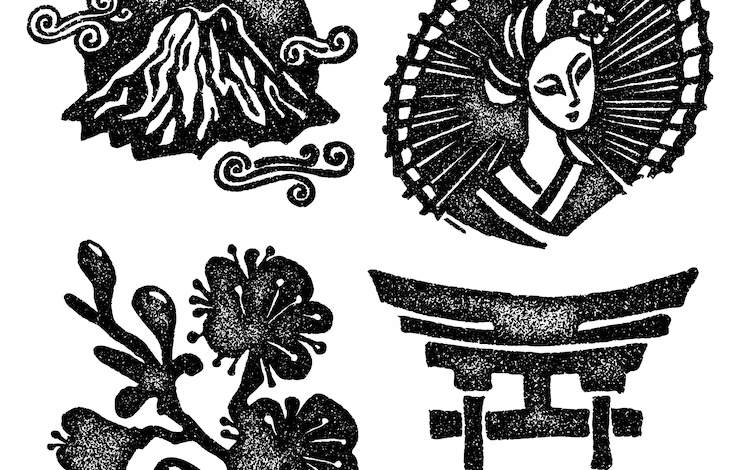Flower in japanese heraldry nyt

Japanese Heraldry and Flowers
Japanese heraldry, known as kamon, is a fascinating world of symbols that tell stories of family, tradition, and nature. These crests, often passed down through generations, are more than just designs—they’re a window into Japan’s history and values. Among the many motifs, flowers hold a special place, with each bloom carrying deep cultural meaning. One flower, in particular, caught the attention of crossword enthusiasts in a New York Times puzzle on September 28, 2024: the wisteria, an elegant symbol in Japanese heraldry. This article dives into why wisteria stands out, exploring its role in kamon, its cultural significance, and the beauty it brings to Japan’s visual heritage. As someone who’s spent time wandering through Japanese gardens and studying these intricate crests, I’ll share insights that blend personal experience with historical context to bring this topic to life.
What Are Kamon? A Quick Look at Japanese Heraldry
Before we focus on wisteria, let’s unpack what kamon are. These family crests originated in the Heian period (794–1185) as a way for aristocrats to show their lineage and status. By the Kamakura period (1185–1333), samurai clans adopted them to identify allies on the battlefield. Unlike Western coats of arms, kamon are minimalist, often featuring simple yet striking designs inspired by nature, like plants, animals, or geometric shapes. They appear on kimonos, architecture, and even modern items like passports.
Flowers are a popular choice in kamon because they carry symbolic weight in Japanese culture. The language of flowers, or hanakotoba, assigns meanings to blooms, making them perfect for expressing a clan’s values. For example, the chrysanthemum, with its 16 petals, is the Imperial Seal, symbolizing longevity and power. But wisteria, with its cascading purple blooms, holds its own unique place in this tradition.
Why Wisteria? The NYT Crossword Clue
On September 28, 2024, the New York Times crossword puzzle featured the clue “Flower in Japanese heraldry,” with the answer “WISTERIA” (8 letters). This clue sparked curiosity among solvers, pointing to wisteria’s prominence in kamon design. Known as fuji in Japanese, wisteria is tied to the powerful Fujiwara clan, a family that shaped Japan’s political and cultural landscape for centuries. The choice of wisteria in the NYT puzzle isn’t random—it reflects the flower’s deep-rooted significance in Japanese history.
As a crossword enthusiast myself, I remember the thrill of solving this clue. It wasn’t just about filling in the letters; it sent me down a rabbit hole of researching kamon and their floral connections. Wisteria’s inclusion in the puzzle highlights its status as one of the Godaion, or five major kamon designs, alongside paulownia, hollyhock, wood sorrel, and melon. Let’s explore why wisteria is so special.
The Symbolism of Wisteria in Japanese Culture
Wisteria, or fuji, is a climbing plant known for its stunning clusters of purple, white, or pink flowers that drape like curtains in late spring. In Japanese culture, it’s more than just a pretty bloom—it’s a symbol of grace, longevity, and enduring connections. The Fujiwara clan, one of the most influential families in the Heian period, adopted the wisteria kamon to reflect their nobility and lasting influence. The cascading flowers mirror the clan’s ability to extend their power across generations, much like wisteria vines spread across trellises.
In hanakotoba, wisteria represents love, tenderness, and sensitivity. Its delicate petals and soft colors evoke a sense of elegance, which is why it’s often featured in art, poetry, and gardens. I recall visiting the Ashikaga Flower Park in Tochigi Prefecture, where wisteria tunnels create a breathtaking canopy of purple. Standing under those blooms, I felt the weight of their cultural significance—each flower seemed to whisper stories of ancient clans and timeless beauty.
The color purple, associated with wisteria, also carries weight. In ancient Japan, purple was reserved for the imperial family and high nobility, making wisteria a fitting emblem for the Fujiwara. This connection to prestige and refinement makes the wisteria kamon a powerful symbol in heraldry.
Wisteria in Kamon Design
The wisteria kamon, often called fuji mon, features stylized clusters of hanging flowers. The design is simple yet elegant, with curved lines that capture the plant’s drooping blooms. Unlike the chrysanthemum’s symmetrical grandeur, wisteria’s kamon has a flowing, organic feel, reflecting the plant’s natural growth. This design appears in various forms, sometimes with leaves or vines, but always retains its graceful essence.
In my studies of Japanese art, I’ve seen wisteria kamon on everything from samurai armor to modern kimonos. The crest’s versatility allows it to blend into both traditional and contemporary settings. For example, during a trip to Kyoto, I noticed wisteria kamon embroidered on a bride’s kimono at a traditional wedding, a nod to her family’s heritage. This blend of past and present shows how kamon remain relevant in Japan today.
Other Flowers in Japanese Heraldry
While wisteria is a star in the NYT crossword, it’s not the only flower in Japanese heraldry. Let’s look at other notable blooms used in kamon:
-
Chrysanthemum (kiku): The Imperial Seal, with 16 double petals, symbolizes longevity and royalty. It’s exclusive to the Emperor and appears on passports and official documents.
-
Paulownia (kiri): Known for its heart-shaped leaves and purple flowers, this crest represents good fortune and is used by the Japanese government.
-
Hollyhock (aoi): Associated with the Tokugawa clan, it symbolizes longevity and divine favor, often seen at shrines like Nikko Toshogu.
-
Wood Sorrel (katabami): A symbol of prosperity and resilience, this crest was popular among samurai for its hardiness.
-
Peony (botan): Known as the “queen of flowers,” it represents wealth and honor, often featured in art and textiles.
Each of these flowers carries a unique story, but wisteria’s elegance and historical ties make it a standout. Its mention in the NYT crossword underscores its cultural weight, inviting solvers to explore Japan’s rich heraldic tradition.
The Cultural Context of Flowers in Japan
Flowers in Japan are more than decorative—they’re woven into the fabric of daily life. The concept of mono no aware, or the bittersweet beauty of impermanence, shapes how the Japanese view flowers. Wisteria, like cherry blossoms, embodies this idea with its fleeting blooms. During my time in Japan, I attended a hanami (flower-viewing) event for wisteria, where locals gathered under blooming trellises to celebrate spring. The atmosphere was joyful yet tinged with an awareness that the flowers would soon fade, a reminder to cherish the moment.
This reverence for nature extends to kamon. Families chose floral crests not just for aesthetics but to express values like resilience, beauty, or loyalty. The wisteria kamon, with its flowing design, captures the balance of strength and grace, making it a perfect emblem for noble families.
Wisteria in Art and Modern Japan
Beyond heraldry, wisteria inspires Japanese art and design. Ukiyo-e prints, like those by Hiroshige, often feature wisteria in vibrant scenes of nature. I once stood in front of Hiroshige’s “Wisteria at Kameido Tenjin Shrine,” marveling at how the artist captured the flower’s delicate beauty against a serene backdrop. This print, part of his One Hundred Famous Views of Edo, shows wisteria’s enduring appeal.
In modern Japan, wisteria remains a beloved motif. It appears in fashion, from kimono patterns to contemporary jewelry, and in festivals like the Fuji Matsuri at Kameido Tenjin Shrine. Tourists flock to places like Kawachi Fuji Garden to walk through wisteria tunnels, a testament to the flower’s lasting allure. As someone who’s explored these sites, I can say the experience is magical—the scent of wisteria in the air feels like stepping into a living piece of history.
How Wisteria Fits into the NYT Crossword
The NYT crossword’s choice of wisteria as a clue reflects its knack for blending niche knowledge with cultural significance. Crosswords often draw on history, art, and global traditions to challenge solvers, and “Flower in Japanese heraldry” is a perfect example. The answer, WISTERIA, fits the 8-letter slot and connects to the Fujiwara clan’s legacy, making it both specific and accessible to those familiar with Japanese culture.
As a solver, I find these clues exciting because they spark curiosity. After cracking this one, I spent hours reading about kamon and their floral roots, which deepened my appreciation for Japan’s heritage. The NYT’s inclusion of wisteria highlights how crosswords can be a gateway to learning, encouraging solvers to explore topics they might not otherwise encounter.
Why Wisteria Matters Today
In today’s fast-paced world, the wisteria kamon reminds us to slow down and appreciate beauty. Its presence in heraldry connects us to Japan’s past, while its use in modern design shows its timeless appeal. Whether you’re a crossword fan, a history buff, or someone who loves flowers, wisteria offers a lens into Japan’s soul.
For me, wisteria is more than a kamon or a crossword answer—it’s a symbol of resilience and grace. During a challenging time in my life, I visited a wisteria garden in Japan, and the sight of those cascading blooms lifted my spirits. They reminded me that beauty can thrive even in tough moments, much like the Fujiwara clan’s enduring legacy.
Conclusion: The Lasting Bloom of Wisteria
Wisteria’s role in Japanese heraldry is a testament to its cultural power. From the Fujiwara clan’s crest to its appearance in the NYT crossword, this flower bridges past and present, art and tradition. Its cascading blooms symbolize grace, longevity, and connection, making it a fitting emblem for families and a beloved motif in Japanese culture.
Next time you see wisteria—whether in a garden, on a kimono, or in a crossword clue—take a moment to appreciate its story. It’s more than a flower; it’s a piece of Japan’s heart, blooming through centuries of history. If you’re curious to learn more, visit a Japanese garden or dive into the world of kamon. You might find, as I did, that wisteria’s beauty inspires a deeper connection to the world around you.



